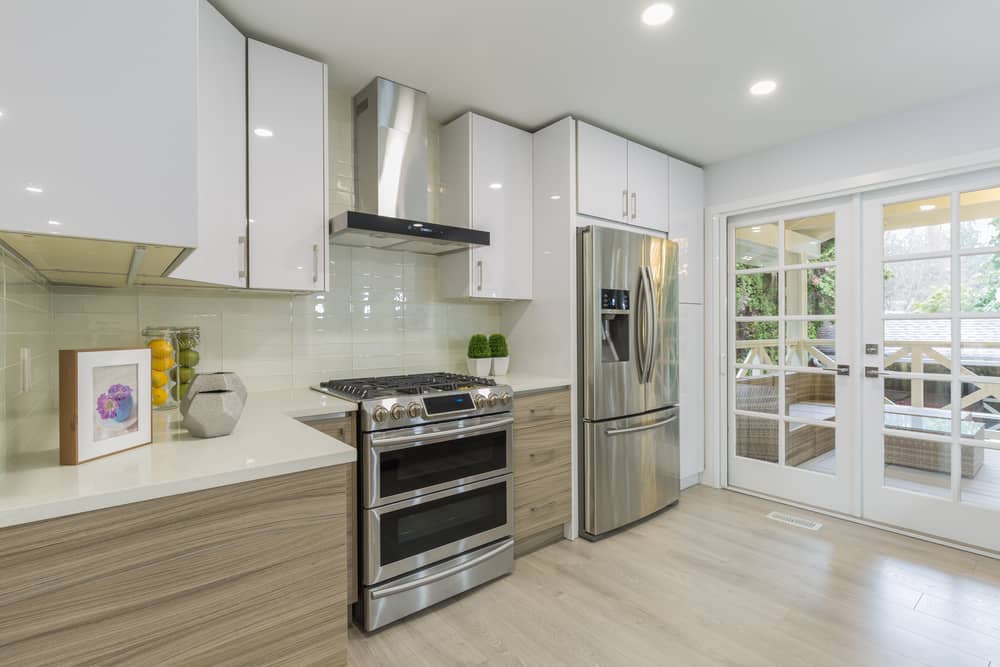Laminate is a popular choice for cupboards and benchtops in your home. It’s durable, non-porous, and affordable – plus, you can get it in a range of colours and finishes!
But much like other surfaces, it needs regular maintenance to keep it clean and looking good. The problem? Laminate, especially the high-gloss type, can get streaky after cleaning.
So – how to clean laminate cupboards without streaking? Warm water and a mild detergent are your best bet, before wiping off all excess moisture to prevent streaks and spots.
Don’t let fingerprint smudges and grease stains ruin your cupboards! Follow these tips to keep laminate looking like new.
How Often to Clean | Before Cleaning | How to Clean | Removing Stains | Cleaning Different Types of Laminate | FAQs
Common Types of Laminate Cabinets
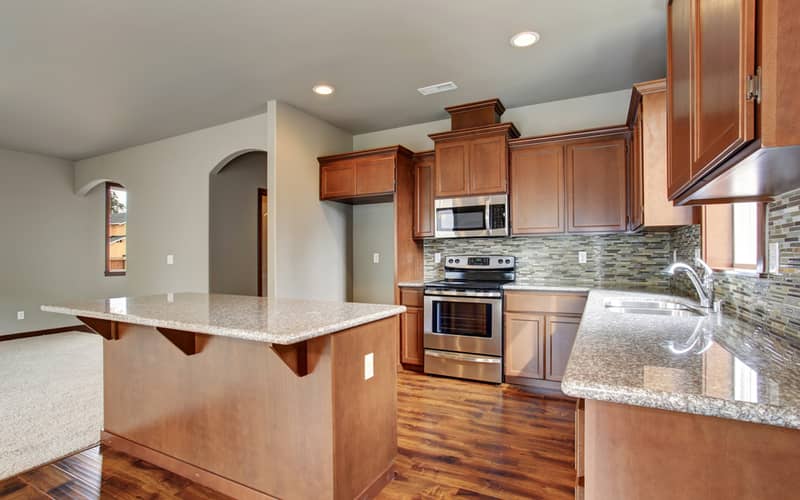
Laminate is a composite material made from different layers fused together under high heat and pressure.
It’s a popular finish since it’s affordable, versatile, and easy to maintain. Laminate also comes in several finishes that you can choose according to your kitchen’s aesthetic!
Matte laminate: A popular, smooth finish that has no shine or gloss. It’s less likely to show streaks or smudges, and has a moderate degree of scratch and abrasion resistance. However, it needs more careful cleaning to maintain that smooth finish.
Gloss laminate: A highly aesthetic finish that adds a mirror-like shine to your cupboards. It lets you highlight certain areas of a room and can make a space feel bigger. It does easily show streams and smudges, but it’s also easy to maintain.
Textured laminate: This material mimics the appearance of other finishes, like wood or marble, but at a more affordable cost. Textured laminate does require more careful maintenance to keep up its appearance.
Acrylic laminate: Acrylic offers a similar appearance to gloss, though with a softer shine. It’s a durable, long-wearing finish that’s moisture- and fade-resistant, but can be costly and prone to scratching.
High-pressure laminate: HPL is seeing more use for kitchen cabinet doors since it’s manufactured to be heat-resistant (up to 135ºC) and hard-wearing. However, it can be costly and hard to source.
How Often to Clean Laminate Cupboards
Routinely clean your laminate cupboards once a week!
For high-touch surfaces like bathroom and kitchen cabinets, you may have to spot clean throughout the week.
Tackle any stains or splatters immediately.
Deep clean the cabinets inside and out once every 3-4 months.
If you want pristine, streak-free laminate cupboards, let a professional house cleaner take charge of the cleaning!
Before Cleaning a Laminate Cupboard
Gather your cleaning supplies so you don’t end up going back and forth. For kitchens, move any appliances out of the way.
To clean laminate cabinets, you’ll need:
- Mild dish soap
- Microfibre or soft cloths
- Soft-bristle brush
- Warm water
- White vinegar (optional)
- Multi-purpose cleaner (optional)
If you live in a hard water area, use distilled or filtered water if possible. Hard water can leave limescale and water spots on laminate surfaces if not fully wiped off.
Wear rubber gloves when cleaning, especially if you’ll be using commercial cleaning products. Always work in a well-ventilated space.
Check with the cabinet manufacturer or installer if there are any products or cleaning agents that you shouldn’t use.
Avoid using abrasive cleaners like steel wool, since you can scratch the laminate surface. Do not use harsh chemicals like bleach and ammonia which might damage the material.
To maintain a streak-free finish, avoid any oil-based cleaners, which can leave a film on the surface.
Cleaning Laminate Cupboards Without Streaking
The real key to cleaning laminate without streaking is to rinse off your chosen cleaner, then buff the cabinet surfaces with a clean cloth to dry.
Wipe in one direction when drying to really make your laminate cabinets shine.
Start by dusting off the cabinets with a dry cloth or duster – front, sides, and top! This gets rid of any loose dirt, dust, and food particles so you don’t create a bigger mess.
And of course, dry the cupboard surfaces quickly to remove excess moisture and prevent water spots.
Using dish soap
Mix about a tablespoon of mild dish soap with 3-4 cups of warm water. Dip a soft cloth into the solution, then wring it out so it’s damp.
Start by wiping the cupboard doors clean, going in small circles. Pay extra attention to any handles or hinges, and don’t forget the door sides and interior surfaces.
Follow ASAP with a damp cloth dipped in clean water to rinse off any soap residue. Then finish with a dry, lint-free cloth to wipe off excess moisture.
Repeat this process with the sides and top of the cupboards. Use a soft-bristled brush to get into any corners and crevices.
Rinse the cupboard surfaces and buff them dry afterwards.
Using white vinegar
White vinegar is excellent at removing smudges and streaks, and it can also break down any build-up of dirt on a laminate surface.
You can do a patch test on an inconspicuous spot first to ensure the acidity won’t cause any damage.
Mix 1 part vinegar with 2 parts warm water in a spray bottle. You can add a few drops of mild detergent for extra cleaning power.
Lightly spritz one cabinet door at a time, then gently wipe the surface clean with a microfibre cloth.
Alternatively, mix the vinegar solution in a bowl, then dip your cleaning cloth in the solution. Wring it out before wiping the laminate doors and benchtop.
Follow with a clean cloth dampened with fresh water to rinse, then another cloth to buff the surfaces dry.
Using all-purpose cleaner
Laminate is non-porous, so many multi-purpose cleaners are safe to use. Check the product label or ask the cupboard manufacturer for any restrictions.
Ajax’s Spray n’ Wipe Multi-Purpose Cleaner is antibacterial, while Simple Green All-Purpose Cleaner has a biodegradable formula.
Follow the product instructions, and thoroughly wipe off any residue with a microfibre cloth. Follow with a clean cloth to dry and buff the surface.
How to Remove Stains from Laminate Cupboards
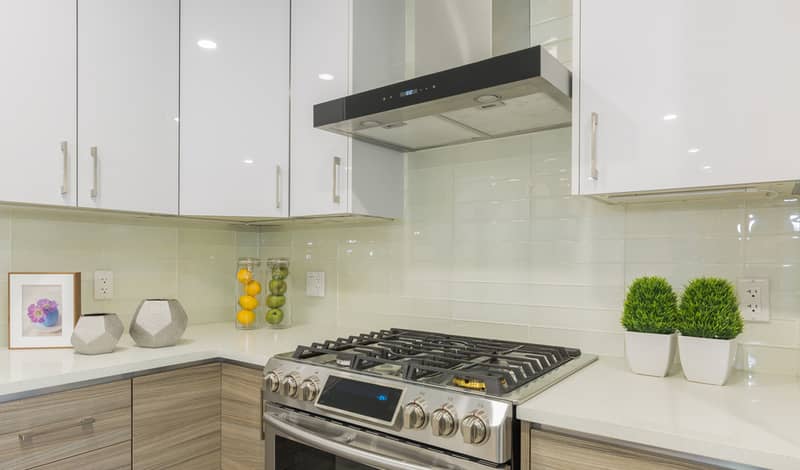
Cabinets are often high-touch surfaces, so there are plenty of opportunities for the laminate to pick up stains, splatter, and other grime.
Thankfully, laminate is durable and non-porous, so there are several effective cleaning methods you can use to remove stains.
Getting grease off laminate kitchen cabinets
Kitchen cabinets see a lot of grease splatter, so it’s essential you tackle any stains ASAP. The longer the mess sits, the harder it’ll be to clean up.
To remove oil stains from laminate cupboards, make a paste of 1 part warm water and 2 parts baking soda. Apply the paste with a non-abrasive sponge to any affected areas.
Leave the paste for a few minutes to absorb the oil and dirt, then wipe off the residue with a damp microfibre cloth.
You can wash the surface with mild soapy water afterwards. Follow with a clean cloth to dry.
For more stubborn stains, try a light spray of Dawn Platinum Powerwash. Its grease-cutting formula doesn’t need water to activate, but make sure you wipe off all residue with a dampened cloth.
Test the Powerwash on an inconspicuous spot first to check that it won’t damage the finish.
Getting food splatters off laminate cupboards
For fresh food messes, wipe up as much as you can with a damp, lint-free cloth. Pick up any solid food or crumbs with paper towels.
Just like grease messes, make a paste made of baking soda and water. Apply it with a non-abrasive sponge and let it sit for up to 10 minutes.
Following that, wipe away all the residue with a damp microfibre cloth. Give the spot a quick wash with a soft cloth and some warm, soapy water.
Rinse with a cloth dipped in fresh water, then buff the area dry.
Getting fingerprints off laminate cupboards
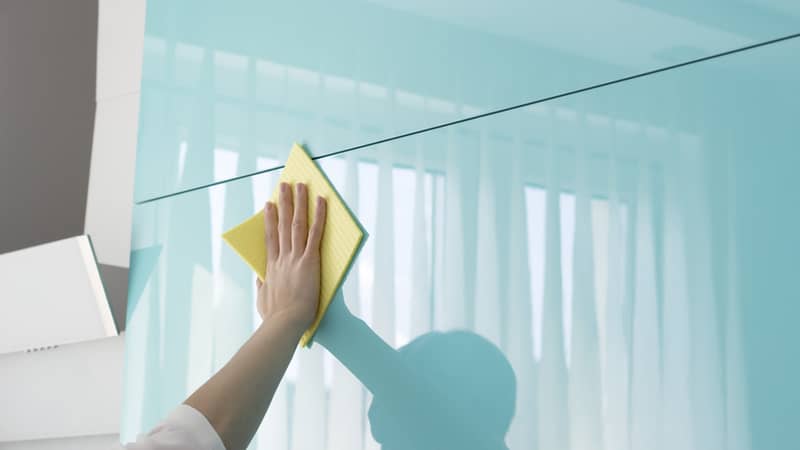
Oils and sweat from your skin can leave fingerprints, smudges, and other marks on cupboards – especially high-gloss finishes.
Spot clean any fingerprints and other marks with a mixture of equal parts white vinegar and water. You can dip a microfibre cloth into the solution or apply it with a spray bottle.
Wipe the marks off, then buff the spot with a dry cloth.
Tips for Cleaning Different Types of Laminate Cupboards
Depending on the type of laminate finish on your cupboards, here are some tips that’ll make cleaning easier and more effective.
Cleaning matte laminate cupboards
Matte cabinets can be slightly trickier to maintain, since they need more careful cleaning to keep that smooth appearance.
When doing regular cleaning, opt for hot water instead of warm, and try some Castile soap! (Dr. Bronner’s Pure Castile Liquid Soap is a great option.)
Use a soft cloth and use just a few drops of soap so it doesn’t leave any residue. Thoroughly dry the matte laminate afterwards so the water doesn’t leave spots.
Spot clean a few times a week to prevent oils, smudges, and other stains from building up.
Cleaning high-gloss laminate cupboards
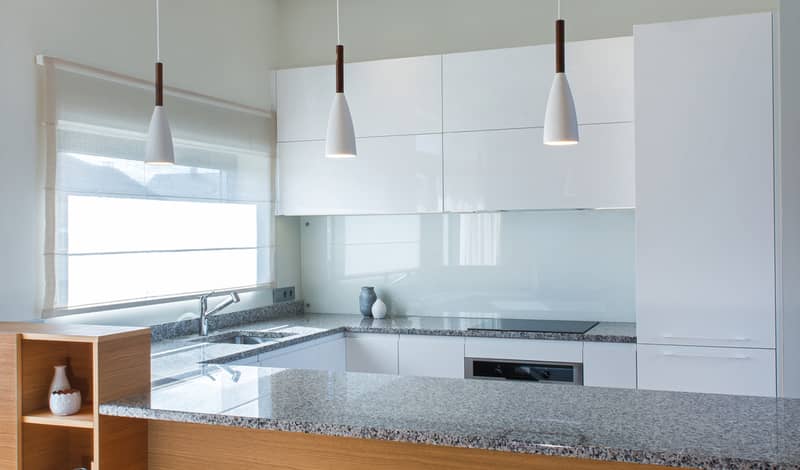
Smudges and stains are the bane of high-gloss cupboards since they show up so easily.
Diluted vinegar with a bit of dish detergent can help remove those marks. Dip a microfibre cloth into the mix and wiping off any smudges works well.
Always work with diluted vinegar as the acid can wear away at the glossy finish over time.
Regular dusting with a soft cloth or duster also helps maintain that shine.
Cleaning dark laminate cupboards
Stick to warm water and an anti-grease dish detergent (Dawn Dish Soap is a classic recommendation).
For stubborn stains, use a solution of 2 parts water and 1 part vinegar. Higher concentrations of vinegar can fade dark colours.
If you’re unsure, do a spot test on an inconspicuous spot first to make sure the vinegar won’t damage that sleek, dark colour finish.
Cleaning white laminate cupboards
Not only do stains show up more on white laminate, but the finish might start yellowing with prolonged exposure to sunlight.
Regular spot cleaning can help prevent dirt and dust build-up. Check with the manufacturer if you can use magic erasers for any minor stains.
A good all-purpose cleaner also works well.
If your white laminate cabinets are turning yellow, the culprits are likely sunlight and age. Exposure will cause the laminate to discolour.
You can try using some diluted hydrogen peroxide to lighten the yellowing, but there’s no permanent fix except to have the laminate replaced or painted over.
Acrylic laminates are less likely to fade due to UV and sunlight exposure.
Other FAQs About Cleaning Laminate Cupboards
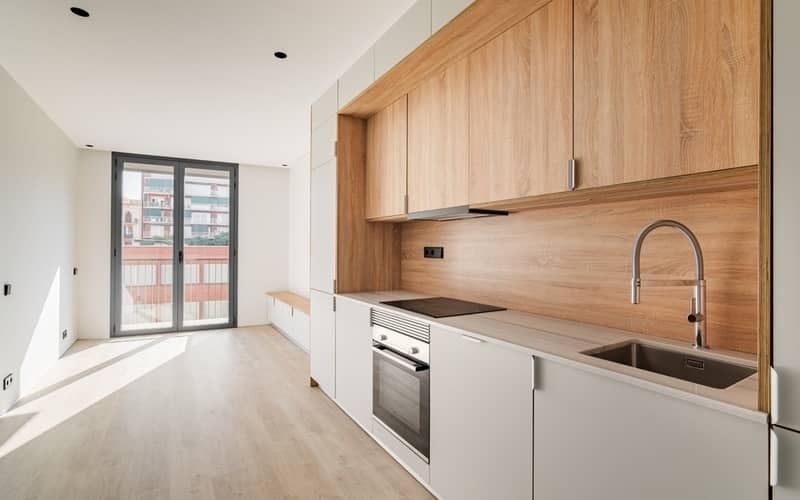
If you have other concerns about how to clean laminate cupboards without streaking, here are some common questions and tips!
What is the best way to clean laminate kitchen cabinets?
Warm water and mild dish soap, plus microfibre cloths, are more than enough for regular cleaning.
You can also use a multi-purpose cleaner that’s formulated for use on laminate!
How to clean matte laminate cupboards without streaks?
Matte laminate and other materials can be tricky to maintain, so it’s best to use hot water and a mild detergent such as Castile soap.
Thoroughly dry your matte laminate cabinets after cleaning to prevent spots and streaks.
What is a natural cleaner for laminate cabinets?
If you prefer natural or organic cleaners, vinegar or castile soap both work well!
Make sure to use them individually, as vinegar can react with castile soap to create a white filmy residue.
For tougher stains, opt for baking soda – it’s only mildly abrasive, so can be used on laminate.

